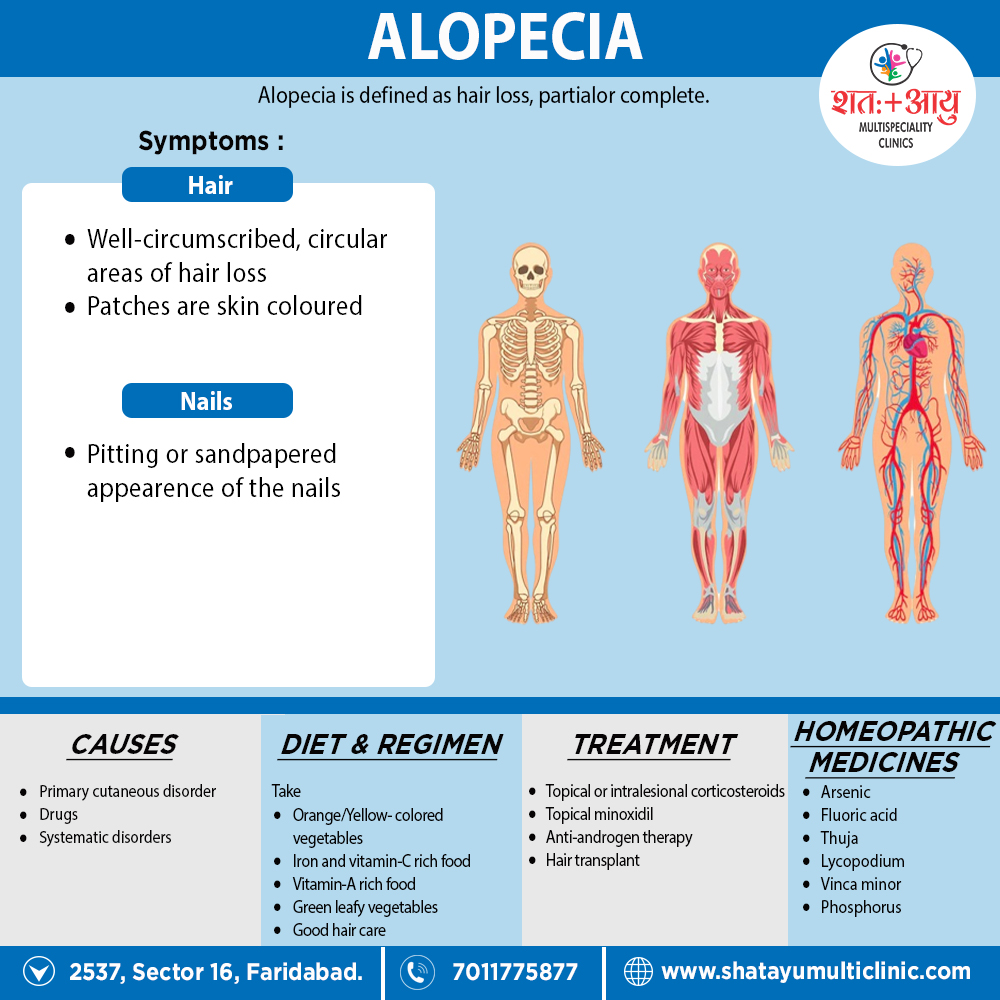Homeopathic Treatment of Alopecia
Homeopathy treats the person as a whole. It means that homeopathic treatment focuses on the patient as a person, as well as his pathological condition. The homeopathic medicines selected after a full individualizing examination and case-analysis.
which includes
- The medical history of the patient,
- Physical and mental constitution,
- Family history,
- Presenting symptoms,
- Underlying pathology,
- Possible causative factors etc.
A miasmatic tendency (predisposition/susceptibility) also often taken into account for the treatment of chronic conditions.
What Homoeopathic doctors do?
A homeopathy doctor tries to treat more than just the presenting symptoms. The focus is usually on what caused the disease condition? Why ‘this patient’ is sick ‘this way’?.
The disease diagnosis is important but in homeopathy, the cause of disease not just probed to the level of bacteria and viruses. Other factors like mental, emotional and physical stress that could predispose a person to illness also looked for. No a days, even modern medicine also considers a large number of diseases as psychosomatic. The correct homeopathy remedy tries to correct this disease predisposition.
The focus is not on curing the disease but to cure the person who is sick, to restore the health. If a disease pathology not very advanced, homeopathy remedies do give a hope for cure but even in incurable cases, the quality of life can greatly improved with homeopathic medicines.
Homeopathic Medicines for Alopecia :
The homeopathic remedies (medicines) given below indicate the therapeutic affinity but this is not a complete and definite guide to the homeopathy treatment of this condition. The symptoms listed against each homeopathic remedy may not be directly related to this disease because in homeopathy general symptoms and constitutional indications also taken into account for selecting a remedy, potency and repetition of dose by Homeopathic doctor.
So, here we describe homeopathic medicine only for reference and education purpose. Do not take medicines without consulting registered homeopathic doctor (BHMS or M.D. Homeopath).
Medicines:
-
Arsenic:
- Touching the hair is painful.
- Bald patches at or near the forehead; besides this scalp covered with dry scabs and scales,
- Looking rough and dirty, extending sometimes even to forehead, face and ears.[4]
- Scalp very sensitive, as a result cannot brush hair.
- Hair become gray early;
- Falling of hair.
- Dandruff [5]
-
Fluoric Acid:
- Itching of the head and falling off of the hair.
- The new hair is dry also breaks off.
- Large patches entirely denuded of hair.
- New hair dry and breaks off.
- Must comb the hair often, it mats so at the end.[4]
-
Natrum Mur.:
- Hair falls out if touched.
- Mostly on forepart of head, temples also beard.
- Scalp very sensitive.
- Face shining as if greasy. [4]
- Nodding motions of the head.
- Headaches of school children.
- Migraine
- Falling hair. [5]
-
Lycopodium:
- Hair becomes gray early.
- Hair falls off after abdominal diseases; after parturition.
- Burning, scalding, itching of the scalp, especially on getting warm from exercise during the day.[4]
- Premature baldness, after abdominal affections, parturition.
- Catarrhal headache agg. when discharge from nose is slacked up.
- Throbbing after every spell of cough, pains when pressing at stools.[5]
-
Phosphorus:
- Generally, Round patches on scalp completely deprived of hair.
- Falling off of the hair in large bundles especially on the forehead and on the sides above the ears.
- The roots of the hair seem to be dry.
- The denuded scalp looks clear.
- White also smooth; dandruff copious, falls out in clouds. [4]
-
Vinca Minor:
- It affects skin and hair and is effective for uterine haemorrhages.
- Furthermore, Weakness and prostration, accompany many sufferings;
- Weakness also faintness as if he would die.
- Mental exertion causes tremulous feeling and tendency to start
- Spots on scalp oozing foul moisture, matting hair together.
- Corrosive itching of scalp.
- Plica polonica (in other words, matted hair).
- Bald spots covered with short wooly hair.
- Hair falls out and is replaced by gray hair.[5]
-
Thuja Occidental:
- In general, Headache aggravate by sexual excess, from tea.
- Amelioration bending head backwards.
- Tearing, jerking pain.
- White scaly dandruff.
- Hair at first dry, then split; and at last falls out.
- Sweat smelling like honey. [5]

